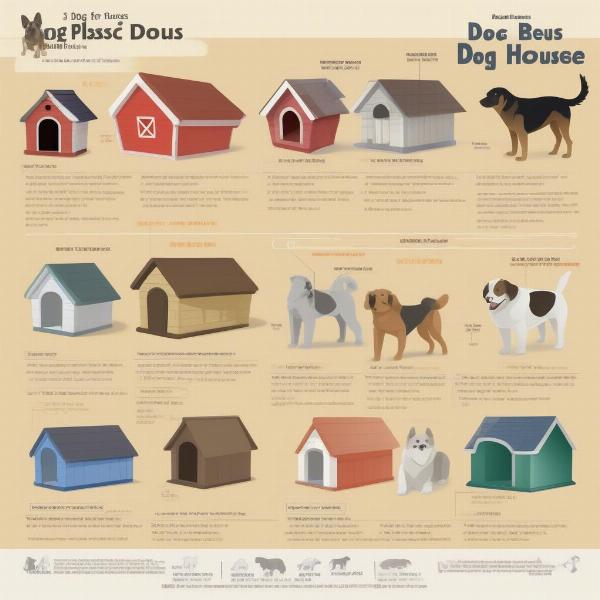Plastic dog houses are becoming an increasingly popular choice for pet owners due to their affordability, durability, and ease of maintenance. But are they the right choice for your furry friend? This article will delve into the pros and cons of plastic dog houses, helping you make an informed decision about whether a plastic kennel is a good fit for your dog’s needs. We’ll explore factors like size, insulation, ventilation, and overall suitability for different climates and breeds.
Choosing the right dog house is a crucial decision, impacting your dog’s comfort, safety, and overall well-being. While traditional wooden dog houses offer a classic aesthetic, plastic options present a compelling alternative with distinct advantages and disadvantages. Understanding these key differences is vital in selecting the perfect outdoor shelter for your canine companion.
Benefits of Plastic Dog Houses
Plastic dog houses offer a number of advantages over other materials like wood or metal. They are typically more affordable, lighter, and easier to clean. Their resistance to rot, insects, and weathering makes them a durable option, especially in harsher climates.
- Easy to Clean: A quick wipe down with soap and water is usually all it takes to keep a plastic dog house clean and hygienic, reducing the risk of parasites and bacteria.
- Durability: Plastic is resistant to rotting, warping, and insect infestations, problems that can plague wooden dog houses.
- Portability: Being lightweight, plastic dog houses are easy to move around your yard or transport if needed.
- Affordability: Generally, plastic dog houses are less expensive than their wooden counterparts, making them a budget-friendly option.
Drawbacks of Plastic Dog Houses
While plastic dog houses have their advantages, they also come with some drawbacks to consider. Insulation can be an issue, making them less suitable for extreme temperatures. They can also be less aesthetically pleasing than wooden options.
- Insulation: Plastic doesn’t insulate as well as wood, meaning these houses can get very hot in the summer and very cold in the winter.
- Ventilation: While many plastic dog houses have ventilation features, maintaining adequate airflow can still be a challenge, potentially leading to condensation and mold growth.
- Durability in Extreme Weather: While generally durable, some lower-quality plastic dog houses can become brittle and crack in extreme cold or fade and warp in intense sunlight.
- Aesthetics: Plastic dog houses often lack the aesthetic appeal of wooden ones, which can be a concern for some homeowners.
Choosing the Right Plastic Dog House
Selecting the right plastic dog house involves considering your dog’s size, breed, and the climate you live in. Ensure the house is large enough for your dog to stand, turn around, and lie down comfortably. Look for features like double-wall construction for added insulation and raised floors to keep your dog dry.
- Size: Measure your dog carefully and choose a house that provides ample space. A house that is too small will be uncomfortable, while one that is too large won’t retain heat effectively.
- Insulation: If you live in an area with extreme temperatures, consider a double-walled plastic dog house or look for ways to add insulation.
- Ventilation: Ensure the house has adequate ventilation to prevent moisture buildup and maintain a comfortable temperature.
 Plastic Dog House Size Guide
Plastic Dog House Size Guide
Maintaining Your Plastic Dog House
Regular cleaning is essential to keep your plastic dog house hygienic. Use a mild soap and water solution and rinse thoroughly. Check regularly for cracks or damage, especially after storms or extreme weather.
Conclusion
Plastic dog houses offer a practical and affordable solution for providing your dog with an outdoor shelter. While they may not be suitable for all climates or breeds, their durability, ease of cleaning, and portability make them a viable option for many pet owners. By carefully considering your dog’s needs and the climate you live in, you can choose a plastic dog house that provides a comfortable and safe haven for your furry friend. Remember to prioritize proper sizing, ventilation, and insulation for optimal comfort and well-being.
FAQ
- Are plastic dog houses safe for dogs? Yes, plastic dog houses are generally safe for dogs, provided they are made from non-toxic materials and are the appropriate size.
- How do I clean a plastic dog house? Use a mild soap and water solution and rinse thoroughly.
- Can plastic dog houses be used in winter? Yes, but you may need to add extra insulation or consider a double-walled model for colder climates.
- How long do plastic dog houses last? With proper care, a plastic dog house can last for several years.
- Are plastic dog houses chew-proof? While durable, they are not entirely chew-proof. Supervise your dog, especially if they are prone to chewing.
ILM Dog is your trusted resource for all things dog-related. We offer expert advice on dog breeds, health, training, nutrition, grooming, and much more. From indoor dog house options to understanding how to keep dogs from urinating on rugs, we’ve got you covered. We also have resources on building a dog house shed and ensuring your dog with water bowl is always hydrated. Looking for unique gifts? Check out our personalised dog toy box. For expert guidance and personalized support, contact us via email at [email protected] or phone at +44 20-3965-8624. ILM Dog is here to help you provide the best possible care for your canine companion.